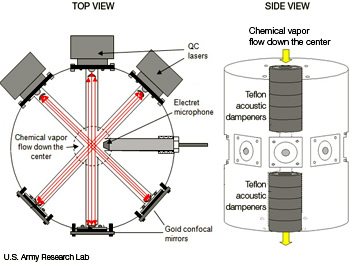
A device based on selective real-time detection of gaseous nerve agent stimulants using multi-wavelength photoacoustics could look like this, in which multiple lasers are now used.
Nearly a century after the use of mustard gas in World War I, governments still worry about the possibility of chemical attacks. Researchers at the U.S. Army Research Laboratory (Adelphi, Md.) have devised a photoacoustic technique for sensing trace amounts of gases that simulate deadly nerve agents (Opt. Lett. 37, 3474).
Scientists have long used photoacoustic spectroscopy in the laboratory to measure absorption parameters of single trace gases, says the article’s lead author, Kristan P. Gurton. He wanted to take this sensitive but limited bench-top technology and modify it for detecting multiple types of molecules in the field.
Recent advances in mid-infrared quantum cascade lasers (QCLs) and on-chip signal processing enabled the technique, according to Gurton. His team’s proof-of-concept device incorporated three lasers with wavelengths ranging from 8.72 to 10.54 µm, with each laser modulated at a different acoustic frequency (1,300 to 1,700 Hz) to help distinguish among the acoustic responses of the molecules. The Army team used one customized QCL and two conventional carbon-dioxide lasers, but the technique could work with three to six QCLs.
Instead of putting the gas of interest in a closed cell, Gurton and colleagues passed the gaseous sample through an open cylinder with a microphone in the center. The laser beams were propagated across the gas flow through the cylinder. The commercially available digital signal processing card, with its lock-in amplifiers, separated the signals from the microphone and measured the absorption parameters of the simulated toxic gases. Acoustic dampeners at each end of the cylinder enabled the system to function in the relatively noisy lab environment.
Many schemes for guarding against chemical attacks rely on remote detection, but the Army device, if built entirely with QCLs, could fit on an unpiloted drone or in an enclosed space such as a train tunnel. The QCLs may be customized to wavelengths that will resonate with other gases of interest.
Gurton’s team has patented the technique, but he hopes that other researchers will extend and commercialize it.
